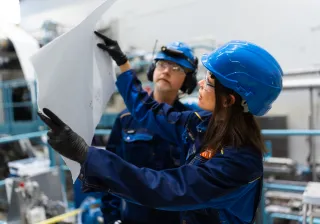Sensing innovation co-developed by Fläkt Woods and VTT.
- Healthy and comfortable indoor climate depends on sufficient ventilation at all times
- Present ventilation systems are unable to adjust depending on room occupancy
- Too little ventilation in a full room makes air stuffy. Too much ventilation in an empty room incurs unnecessary costs
- The biggest challenge in truly demand-controlled ventilation has been the unavailability of suitable flow sensors
-
Fläkt Woods, together with VTT, developed an ultrasound airflow measurement system
-
An ultrasound pulse is transmitted across the air duct and its deflection measured for extremely accurate airflow speed measurement
-
The ultrasound method eliminates typical sources of error, such as turbulence after bends and T-joints
-
Because there are no objects in the flow channel, the system is maintenance-free, quiet and precise without pressure losses
-
The innovation ensures that just the right volume of air is pumped into a room even when its occupancy changes
-
The ultrasound measurement system can be installed in tight spaces, ideal for renovation projects
-
Accurate demand control reduces ventilation energy costs by 45–50 per cent
-
As there are no components in the duct that need cleaning or servicing, ventilation maintenance costs can also be reduced
Ventilation leader in search of better solutions
FläktGroup, originally established in Sweden in 1918, is now a European market leader for energy-efficient air technology solutions. FläktGroup, the indoor air comfort and fire safety division of the Group, employs 3,700 people in 65 countries, generating €680m in annual turnover. Fläkt Woods's solutions improve air quality in offices, hotels, hospitals, airports and commercial construction projects, including specialist applications such as the pharmaceutical, marine, nuclear, oil and gas industries.
How to achieve correct ventilation based on room occupancy?
A healthy, comfortable and productivity-enhancing indoor climate can only be created by making sure ventilation accurately responds to the needs of the people occupying the space.
Current ventilation systems, based simply on estimated average occupancy, are not capable of adapting to changes in the use of indoor spaces. For example, the air in a conference room or a classroom quickly becomes stale if more than the predetermined number of people are present – or the ventilation may work at full speed even if the room is empty, wasting energy and money.
The biggest challenge in creating truly demand-controlled ventilation systems has been that suitable flow sensors are not available.
Ultrasound measurement – no pressure drop, no noise, accurate control
Fläkt Woods's new OPTIVENT® ULTRA, developed in collaboration with VTT and coupled with modern control technology, achieves a high level of both indoor air quality and energy efficiency. VTT's new, extremely accurate flow sensor based on ultrasound enables reliable measurement across the entire flow range, even at low flow rates.
The collaboration between Fläkt Woods and VTT is a perfect example of needs meeting. We at Fläkt Woods saw the need for a better measuring solution and have the resources to productise it and fit it to solve our customers' problems. Then again, few commercial companies have the time or budget for in-depth basic research – which is exactly what VTT brought to the table,
says Timo Kaasalainen, Product Manager, Fläkt Woods.
The airflow is guided by temperature or CO2 sensors installed in the room that detect changes in occupancy. An ultrasound pulse is transmitted radially across the air duct and the "bending" of the signal due to airflow speed is measured differentially using MEMS (Micro Electro Mechanical System) microphones. This measurement system eliminates several sources of error, such as turbulence after bends and T-joints, and obtains highly accurate measurements.
Because there are no objects in the flow channel, and no orifice plate is needed, no dirt-gathering or bulky measuring devices are needed. In addition, the absence of an orifice plate eliminates noise. The new maintenance-free, quiet, precise and intelligent sensor solution does not cause pressure losses as it does not physically interfere with the airflow.
VTT has been developing silicon-based MEMS sensors since the 1990s. This airflow measurement method can also be used in many novel industrial and automotive applications.
Our product development made a good decision when they got in touch with VTT. Co-innovation made it possible to combine VTT's basic research based on a long experience and lots of competence with Fläkt Woods's market knowledge and large-scale technology implementation expertise. I am very satisfied how it all worked out.
Timo Kaasalainen, Product Manager, Fläkt Woods
Better indoor climate at half the cost
The new flow controller allows just the right volume of air to be pumped into a room, based on the current need. The overall lifecycle costs of a property fall when the ventilation is demand-controlled and works precisely.
The ultrasound measurement system can be installed in tight spaces, and largely eliminates the requirement for a minimum distance from airflow disturbance. This, combined with easy installation in the duct, makes the system ideal for renovation projects.
Our product development made a good decision when they got in touch with VTT,
Mr Kaasalainen says.
Co-innovation made it possible to combine VTT's basic research based on a long experience and lots of competence with Fläkt Woods's market knowledge and large-scale technology implementation expertise. I am very satisfied how it all worked out.
Accurate demand control reduces ventilation energy costs by 45–50 per cent, and as there are no components in the duct that need cleaning or servicing, ventilation maintenance costs can also be reduced.





